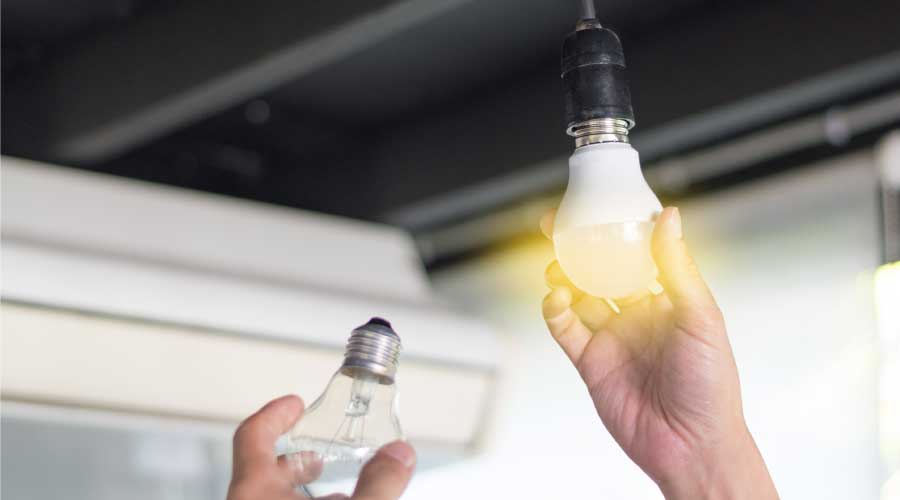Advances In Lamp Technology Offer Energy Efficiency, High Performance
When it comes to lamps, such high-performing technologies as T8s and T5s, combined with the advent of solid-state LED systems, have offered exceptional energy-efficiency and performance for both new construction and retrofit opportunities in recent years. Even today's metal halide lighting offers improved lumen maintenance. Longer lamp life in more advanced lighting — up to 84,000 hours for some fluorescent lamp types, 50,000 hours at 70 percent lumen depreciation (L70) for many LED lamps and up to 100,000 hours (L70) for LED luminaires, for example — can help meet multiple sustainability goals, such as reduction in use of natural resources, in transportation-related air pollution, and in primary energy usage in manufacturing, according to Jennifer R. Dolin, manager of sustainability and environmental affairs at OSRAM Sylvania.
According to Larry Leetzow, president of Magnaray International Division, twin T5 and linear T5 fluorescent sources now have rated 60,000-hour life on a single start/day. "They are inexpensive to replace and maintain 90 percent lumen output vs. 70 percent for LED systems," he says. "Using new T8 sources on a 24/7 basis, in such areas as parking garages, will provide 75,000 to 84,000 hours of life at a very reasonable cost."
Looking At LEDs
Many in the lighting industry say that the future continues to point toward the ongoing development of LED technology. "New options in LED lighting have made it much easier to bring this energy-efficient technology to the office," GE's Walsh says. "While fluorescent lamps have largely reached their potential, LED is still rapidly evolving."
Control is one factor facility managers should consider when evaluating LEDs. "We have reached a point that if facilities want to control lighting systems, it simply is more affordable to use LED luminaires versus traditional fluorescent alternatives when considering indoor ambient lighting solutions," says Bob Smith, director, energy marketing solutions with Eaton's Cooper Lighting business.
LED lighting also provides the potential to "tune" the color of the light to achieve different hues of whiteness. According to Acuity's English, this can be useful in retail areas, for example, because it enhances the appearance of merchandise.
"In spaces where there is daylight integration, the LED lighting can adapt to match the changing color characteristics of the daylight throughout the day," she adds.
LED retrofits can reduce maintenance costs, while LED life continues to extend well beyond the 100,000 hour mark, says Ben Peterson, president of Deco Digital Lighting Systems. "Lower energy consumption plus lower maintenance means a tremendous near-term savings," he says.
What's more, many solid-state lighting systems provide the benefit of modular upgrades, adds English. She notes that while LED tube replacements may not provide the optimally desired level of glare or distribution performance, luminaires with replaceable boards and drivers allow facility managers to upgrade lighting without having to dispose of materials that go into landfills.
"Even when materials are recycled, there is embodied energy needed to recycle them," English explains. "So the optimal sustainability solution is to eliminate waste to the greatest extent possible."
And, as Peterson notes, LED lighting doesn't need to be intimidating.
"In some ways, it's actually much simpler than traditional incandescent HID or fluorescent lighting," he says. "Not long ago, LED lighting was considered the future. The technology grew up faster than most people thought. The future is now."
Outside the Box
Gains in technology have not been limited to indoor lighting. Outdoor lighting has seen gains in a range of areas. For example, improved optics can reduce light pollution, which affects neighboring properties or natural habitats. And new control technologies can make outdoor lighting more responsive to activities.
"A large outdoor parking lot can be designed to result in significantly lower energy consumption by controlling the lights by zones, using improved daylight sensors and even using vacancy sensing that reduces the light levels when the area is unoccupied," says Cheryl English, vice president of government and industry relations for Acuity Brands.
Advanced outdoor control systems can be managed wirelessly from a computer in a remote location. These systems allow facility managers to set and adjust schedules based on different events and adjust individual lights at any time. The systems also can provide feedback regarding maintenance to ensure that a facility maintains a safe, secure environment.
"For outdoor lighting, in addition to proper illuminance levels, good lighting uniformity is extremely important to navigate safely and improve security and is very dependent on the luminaries chosen," says Jennifer R. Dolin, manager of sustainability and environmental affairs at OSRAM Sylvania. "Many of the new LED outdoor luminaires provide better lighting uniformity than luminaires with HID lamps."
|
Related Topics:














